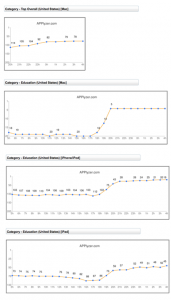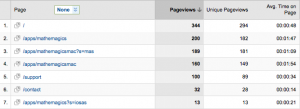Your Website Matters with the Mac AppStore
We’re a little over a week into the launch of the Mac AppStore and by all early signs it’s going to be a hit. I personally couldn’t be more pleased with the launch of my new Mac app, Mathemagics. In fact, it had the good fortune of being an Editor’s Pick at Macworld on Tuesday of last week. I almost fell out of my chair when I first saw the post. Macworld carries some oomph. As you can see the impact on sales was noticeable.
You get one guess to name at what point the Macworld Editor’s Pick went live. Interestingly the iPhone version of the app was also positively impacted. In fact, raw downloads for the day were greater for the iPhone/iPad version of the app vs the Mac version. Though not by much.
At least one new customer emailed support and mentioned that he had seen the Mac version of the app and noticed on the company website that we also had an iPhone version of the app. So, he bought that one too. Cross selling for the win! This sort of cross sell is what we hope for and this particular customer confirmed that it does in fact happen. Now, while this is great and having a decent website that clearly showcases your products played an important part in that cross sell it is not the focus of this blog post. I merely mention it and the above download numbers in order to provide a backdrop for the stats that I am about to provide.
By luck or divine intervention the day prior to the Macworld selection I had a brainstorm on a way to definitively track clicks from the AppStore over to the company website. This, to me, is important. Normally, at least via Google Analytics, such clicks just show up as ‘Direct’ which basically means they could have come from anywhere. As we know, stats about who clicks where within the AppStore, how they found your app page, and where they went from there is a black hole as large as the one at the center of the Milkyway Galaxy. So, any insight into that abyss can be incredibly useful information upon which to make important business decisions.
The AppStores provide a link to your company website that some users take advantage of. Currently, the iPhone/iPad AppStore resides within iTunes and has a completely different layout than its sibling the Mac AppStore. The AppStore on the device (iPhone, iPodTouch, etc) shows a truncated link to your website that is not clickable. I doubt many users take the time to enter it manually into mobile safari if they can happen to decipher it.
Between the three AppStores the Mac AppStore is the most clean and the company link is clearly visible and obvious. Links in iTunes are sandwiched between a truncated version of your description and your app screenshots. I’m in the AppStore all of the time and I know where the company link is . However, I still have to hunt for it in iTunes when I want to take a further look. The company link on the device AppStore might as well not even be there.
This link visibility and obviousness has a profound impact on the number of users clicking though to your website. So, how do I know who clicked directly from the AppStore? I add a parameter to the end of my landing page URL’s and use it only within iTunes Connect for the product page link. Edge cases aside this reveals the number of page views originating as a click directly on the company link within the AppStore. Google Analytics will split out the URL with unique parameters as a separate line item and my webserver will safely accept and ignore parameters that it is not interested in.
As you can see the iPhone/iPad version of the app had a paltry 13 page views (s=iosas) which originated as a click from directly within the iTunes version of the AppStore. During the same time frame the Mac version of the app had a robust 189 page views (s=mas) that originated as a click from directly within the AppStore. This despite the fact that the iOS app saw slightly more downloads than the Mac app. The above stats are for the short but intense time period just after the Macworld Editor’s Pick. A longer study lasting over a several month period with more normal traffic is warranted. Just the same, I think that since both apps had similar raw download numbers over the same time frame and the Mac app page views far outweigh those of the iOS app the premise has some legs. (As an aside take a look at the Avg Time on Page stats between the two).
The observed click throughs coming from the AppStores is most likely a combination of the poor design in the iTunes AppStore and the fact that most iOS purchases happen on the device. Whatever the cause it is clear that users are clicking through from the Mac AppStore to take a look at your website. Be ready for them! This is your opportunity to stand out, control the setting, and make your sales pitch.
This post is a part of the iDevBlogADay group of Indie development blogs. Thanks to @mysterycoconut for managing such a great site.


